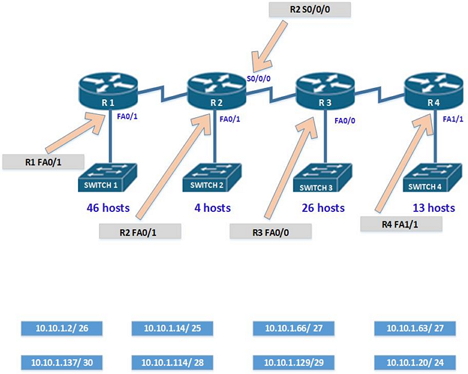As you prepare for your Cisco CCENT (Cisco Certified Entry Networking Technician) or CCNA (Cisco Certified Network Administrator) exam you will definitely hear time and time again that you have to know subnetting inside and out to be able to pass the exam. Not only do you need to be able to answer the straight forward questions like how many hosts can you have with a mask of /26 on a subnet; but you have to be able to do that and marry up your subnetting skills with your Cisco routing and switching knowledge to figure out what subnet a particular host will reside on and what the default gateway address will be for that host. That is because Cisco is going to ask you scenario based questions that make it much harder than just understanding the basics of subnetting. They want you to be able to put together two concepts and sharpen your network troubleshooting skills for the real world. There are many different type of scenario questions that you may see on the exam. Below you will see one which you have to use your CCNA subnetting skills to pick the most efficient subnet masks to conserve IP addresses. So let’s take a look at the exam question below.
Company D is redesigning the network that connects its three locations. The administrator gave the networking team 10.10.1.0/24 to use for addressing the entire network. After subnetting the address, the team is ready to assign the addresses. As a member of the networking team, you must address the network and at the same time conserve unused addresses for future growth. With those goals in mind, drag the host addresses on the left to the correct router interface.

So let’s take a minute to walk through the way to solve this question on your exam. In this question, the main subnet is 10.10.1.0/ 24. The table below shows the subnets in this ip address range.

However, not all the IP addresses can be used. In this question, 10.10.1.2/26 is correct and fits for the subnet that needs 44 hosts, 10.10.1.129/29 is used on the subnet requiring 4 hosts. 10.10.1.137/30 is used on the serial interface between R2 and R3, 10.10.1.66/27 is used for the link requiring 26 hosts on router R3 and 10.10.1.114/28 on R4 which requires 13 hosts.
10.10.1.14/25 and 10.10.1.20/24 would waste too many host ip addresses.
10.10.1.63/27 is not a valid host address in this subnet.
So the correct answer for this question would be as follows:
R1 FA0/1 – 10.10.1.2/26
R2 FA0/1 – 10.10.1.129/29
R3 S0/0/0 – 10.10.1.137/30
R4 FA0/0 – 10.10.1.66/27
R5 FA1/1 – 10.10.1.114/28
For more information refer to the topic on subnetting here.
Are you interested in really getting your hands dirty with a real Cisco routers and real Cisco switches like that you will see in the real world? Do you want to be able to replicate a topology like the one above and really see if your subnetting skills are tight and routing will really work? If so, check out some of the CCNA lab kits that are available here! www.CertificationKits.com

